I have two drill presses, a bench mounted Startrite from the UK which I have had for 40 years and a floor mounted Craftsman from the USA which has only been with me for 10 years. Surprisingly neither have a rack and pinion height adjustment. That has never been a problem with the Startrite but the Craftsman has a double table setup which of course is heavier and took considerable effort to change table height.
I have always like the idea of counter weighting moveable heavy objects and that is what I did with the drill table. I hung a pulley from a clamp at the top of the column, drilled a 2.5 mm hole in the table for a thin steel cable which passed through the pulley down to an old lathe face plate as the counter weight. The faceplate weighed 11 kg which seemed to slightly overcompensate for the table weight.
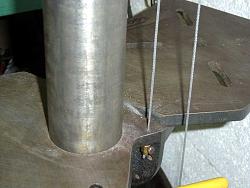

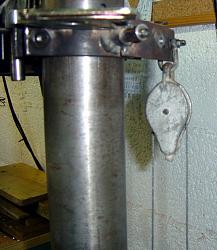
Click photos for full size.
These photos show the table fixing, the pulley and the original counterweight.
This arrangement worked well enough except that the diameter of the faceplate was a sizeable proportion of the available vertical movement space and it interferred with the table clamp lever when I wanted the table set in a low position, for years I have been intending to make a lead weight to replace the faceplate. The higher density of lead would result in a much smaller weight.
Recently, I got so fed up with bruising my knuckles on the faceplate that I started collecting whatever lead I had laying around. mostly I had some old lead plumbing, but there were old wheel balance weights and a diving belt weight from my water based youth. In all it weighed in at 10 kg, just about right. The scrap tube box yielded a short length of 100 mm diameter steel tube. A quick calculation showed that it was just a touch longer than necessary to hold 10 kg of lead. Lady luck smiles sometimes. I welded a plate to close off the bottom and added a support loop at the top.

On the left is the empty steel pot, to the right is some of the lead waiting to be melted.
It was time that we had a bonfire to get rid of some garden waste and it seemed convenient to use that to melt the lead. I decided to use the final container as its own melting pot, which meant that I had to melt the pieces in stages. That is, fill the pot with what I could, let it melt down and create space for more pieces.


Showing the convenient foundry, the length of steel water pipe exiting the fire surround was used to hold the pot in the fire.
That worked well, and I ended up with a pot nearly full of lead but with a layer of dross on the top, some of the plumbing lead pipe was quite dirty inside and the wheel weights had embedded steel pieces which also floated to the top. I didn't really want to play around with the dross to remove it and as it was contained within the height of the pot I decided to simply seal it off with some polyester resin.
I wrapped some Gorilla tape around the top for some added height to contain any excess resin, mixed some resin and simply poured it over the top, then left it to set. The photos show how it set with a volcanic like top surface. It was obvious that whilst still liquid it seeped down into gaps in the dross which gave rise to air bubbles rising to the top leaving the rough surface. That's no problem except aesthetically. A quick spay of paint and it was ready for use.

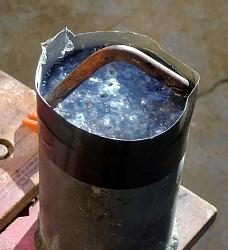
On the left is the pot after the melting, the dross which floated to the top is clearly visible. Next shows the resin seal and finally the painted pot ready for use.
A final weighing came out at spot on 10 kg. I now have the full range of table movement without bashing my knuckles and it is quicker to move the table large amounts than with a normal rack and pinion system.
Showing the finished counter weight in service.
FWIW. the density of lead is 11,340 kg/m^3, with that piece of information you can calculate the space needed for a given weight.
I would love to fully counter balance the table and knee of my milling machine but that would need a 350 kg weight which is somewhat impractical. In a previous post http://www.homemadetools.net/forum/k...5951#post82823 I did outline how I partially balanced that weight which reduces the effort to raise and lower the table by a noticeable amount.
PS. Lead has been determined to be dangerous to health so if anyone follows this example I suggest taking sensible precautions.


 LinkBack URL
LinkBack URL About LinkBacks
About LinkBacks

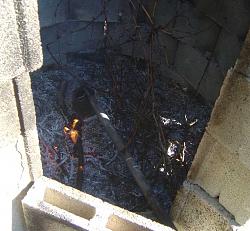
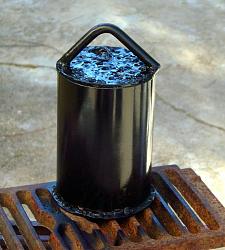



 Reply With Quote
Reply With Quote




 ). The older one gets the heavier these things become..../The older I am the faster I was (old motorcyclist adage)
). The older one gets the heavier these things become..../The older I am the faster I was (old motorcyclist adage)



Bookmarks